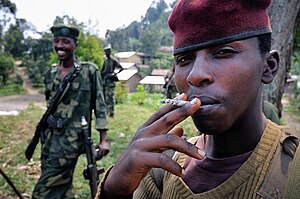Neo-Mai-Mai Conflict
| Neo-Mai-Mai Conflict | |||||||
|---|---|---|---|---|---|---|---|
| Part of Asemese Conflict | |||||||
 Neo-Mai-Mai militants near Tiéoul | |||||||
| |||||||
| Belligerents | |||||||
|
|
| ||||||
| Commanders and leaders | |||||||
|
|
Felix Ko Hiérothée Woro Portien Sogbéni Théodose "Tuka" Tukadzimbi † Robespierre Dàmàmou Dieudonné "Didi" Oupamfo † | ||||||
| Strength | |||||||
| 75,000 | 5,000 ~ 7,000 | ||||||
| Casualties and losses | |||||||
| 11,589 Killed | Unknown | ||||||
|
~40,000 Civilians Killed or Wounded 100,000 Internally Displaced | |||||||
The Neo-Mai-Mai Conflict is an ongoing conflict in Upper Asema. The term Neo-Mai-Mai Conflict is used to refere to several localized conflicts between Mai-Mai militias and other local communities and the government. The conflict is seen as a continuation of the Third Asemese Civil War. the conflict started during the larger Asemese Remobilization Crisis between President Jean-Pierre Dweh and then High Commissioner Jean-Évangéliste Belehyi. The conflict is traditionally seen as starting on 2 June 2002 when former APRP forces would reorganize to form the Bush Rangers, under the leadership of former APRP Leader Dieudonné "Didi" Oupamfo, a Dweh Loyalist during the civil war. The Bush Rangers would attack rural Gbenende communities, which had traditionally been anti-Dweh strong holds and now pro-Belehyi strongholds.
This attack would cause a cascading effect, which multiple pro-Dweh ethnic communities forming new Mai-Mai forces to attack oppositional communities. This violence exploded in the aftermath of the 2003 Asemese Coup d'état when Dweh was deposed by pro-Belehyi forces. This would result in a coalition of Neo-Mai-Mai attacking the city of Symphoreville, A small International Peacekeeping force was able to fight these forces back with help from local Government forces.
After the coup and unsuccessful assault of Symphoreville saw these Neo-Mai-Mai fighting in the rural interior. In the Tsitowodzi Massif Region the conflict transitioned into a mineral war between transnational mining coglomerations, government forces, and local pro-Government Mai-Mai militias and these Neo-Mai-Mai, seeking to control the major Copper and Bauxite resources in the region, later large Diamond mining operations would be used to finance Neo-Mai-Mai operations. In the northern regions the conflict would manifest as a conflict between Pastoral nomads and sedintary farming communities. Fighting over important water resources and fertile grazing lands within mostly arid savannah. This has also brought Neo-Mai-Mai militants into conflict with the Unified Autonomous Liberation Army of Gbaysi as well as Ingternational Intervension Forces in the Gbaysi region.
As of 2022 the conflict has claimed over 50,000 lives and displaced over 100,000 people.